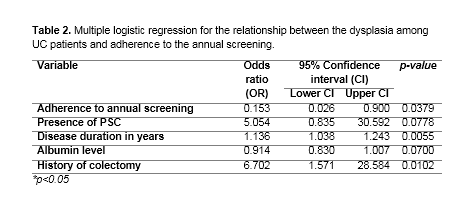P323 The Rate of and Risk of Dysplasia in Long Standing Ulcerative Colitis Patients Among Middle-Eastern Population
Altuwaijiri, M.(1); Alharbi, O.(1); Alruthia, Y.(2); Aljebreen, A.(1); Almadi , M.(1); Almalki , Y.(1); Alrashed, A.W.(1); Alzahran, S.A.(1); Almuhaya, H.(1); Alhowaish, N.(1); Alshehri, K.F.(1); Alrushud , S.S.(1);Alanazi, W.S.(1);Azzam, N.(1)*;
(1)King Saud University, Department of Medicine- Division of Gastroenterology, Riyadh, Saudi Arabia;(2)King Saud University, Department of Clinical Pharmacy- College of Pharmacy, Riyadh, Saudi Arabia;
Background
Patients with long-standing Ulcerative Colitis (UC) are at high risk of getting colorectal cancer (CRC). Therefore, surveillance colonoscopy is recommended to minimize that risk.
Aim: To examine the rate of dysplasia alongside the clinical, biochemical and endoscopic variables associated with dysplasia among patients with long-standing UC in a university-affiliated tertiary care center.
Methods
This was a retrospective medical chart review was conducted. UC patients with a disease history of ≥ 8 years or had primary sclerosing cholangitis (PSC) and underwent colonoscopy surveillance between 2010 and 2021 were included. Patients’ endoscopic and histopathological characteristics as well as their adherence to annual surveillance colonoscopy were assessed.
Results
Two-hundred and sixty patients were included with a mean age and duration of illness of 45 years and 15 years, respectively. Most of the patients were females (55%) and did not adhere to the annual surveillance (56%). About 59% of the patients were in remission, and 48% of them had pancolitis, 35% had left-sided UC, and 17% had proctitis. The percentage of treated patients with monoclonal antibody (mAb) among those who adhered to the annual surveillance colonoscopy was twice that among those who did not adhere to the annual surveillance colonoscopy (34% vs. 17%). The odds of detecting dysplasia among those who adhered to regular annual colonoscopy was 78% lower in comparison to their counterparts who did not adhere to the annual colonoscopy (OR= 0.153, 95% CI= 0.026 – 0.90, p-value=0.0379) controlling for the presence of PSC, disease duration, history of colectomy, and baseline albumin level. On the other hand, patients with longer disease duration had higher odds of dysplasia detection in comparison to their counterparts with shorter disease duration (OR= 1.136, 95% CI= 1.038 – 1.243, p-value=0.0055).
5). .
Conclusion
Adherence to the annual colonoscopy among high-risk UC patients was associated with lower rates of dysplasia detection. However, the rates of dysplasia detection among patients with poor adherence to the annual colonoscopy were lower that the ones reported in the literature. Future studies with larger sample sizes and longer follow-up periods are needed to confirm these findings.




